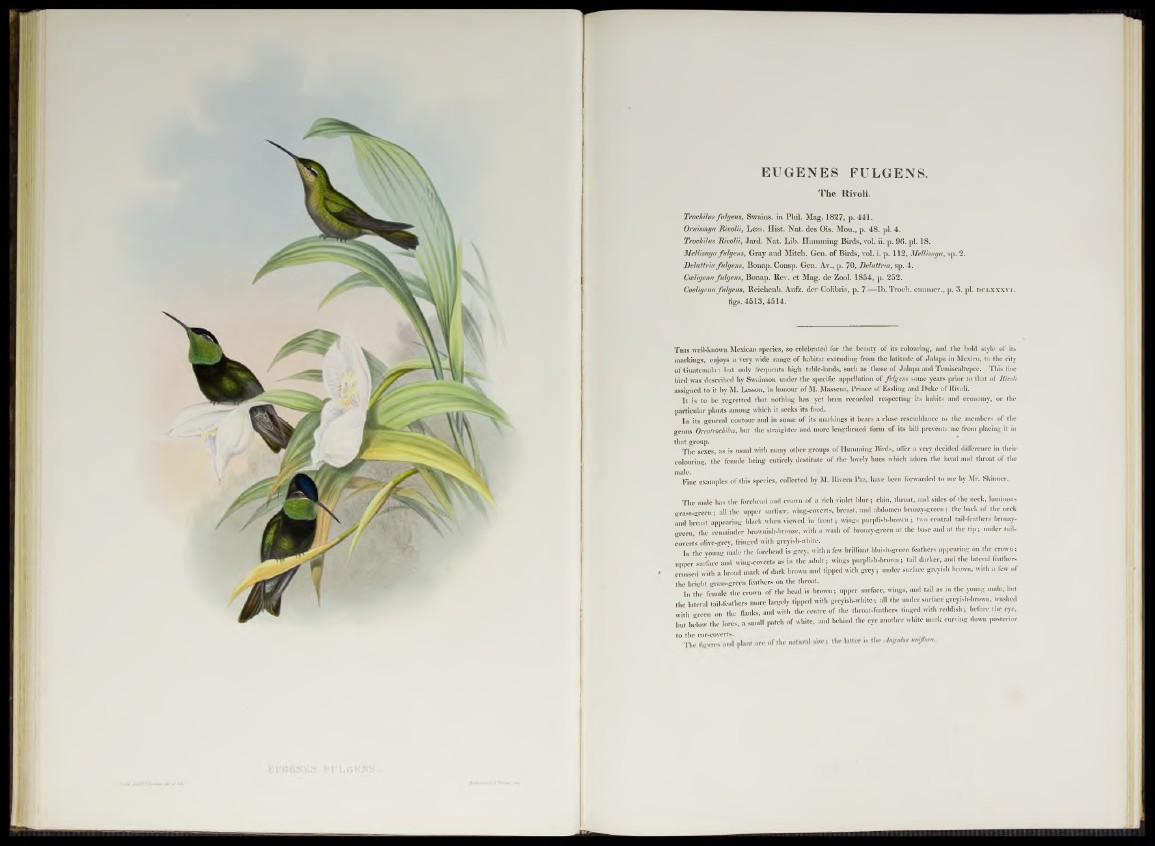
EUGENES FULGENS.
The Rivoli.
Trochilus fulgens, Swains. in Phil. Mag. 1827, p. 441.
Ornismya Rivolii, Less. Hist. Nat. des Ois. Mou., p. 48. pl. 4.
Trochilus Rivolii, Jard. Nat. Lib. Humming Birds, vol. ii. p. 96. pl. 18.
Mellisuga fulgens, Gray and Mitch. Gen. of Birds, vol. i. p. 112, Mellisuga, sp. 2.
Delattria fulgens, Bonap. Consp. Gen. Av., p. 70, Delattna, sp. 4.
Cceligena fulgens, Bonap. Rev. et Mag. de Zool. 1854, p. 252.
Coeligena fulgens, Reichenb. Aufz. der Colibris, p. 7.—Ib. Trocli. enumer., p. 3. pl. d c l x x x v i .
figs. 4513,4514.
T his well-known Mexican species, so celebrated for the beauty of its colouring, and the bold style of its
markings, enjoys a very wide range of habitat extending from the latitude of Jalapa in Mexico, to the city
of Guatemala: but only frequents high table-lands, such as those of Jalapa and Temiscaltepec. This fine
bird was described by Swainson under the specific appellation of fulgens some years prior to that of Rivoli
assigned to it by M. Lesson, in honour of M. Massena, Prince of Essling and Duke of Rivoli.
It is to be regretted that nothing has yet been recorded respecting its habits and economy, or the
particular plants among which it seeks its food.
In its general contour and in some of its markings it bears a close resemblance to the members of the
genus Oreotrochilus, but the straighter and more lengthened form of its bill prevents me from placing it in
that group.
The sexes, as is usual with many other groups of Humming Birds, offer a very decided difference in their
colouring, the female being entirely destitute of the lovely hues which adorn the liead and throat of the
ma)e. *
Fine examples of this species, collected by M. Rivera Paz, have been forwarded to me by Mr. Skinner.
The male has the forehead and crown of a rich violet blue; chin, throat, and sides of the neck, luminous
grass-green; all the upper surface, wing-coverts, breast, and abdomen bronzy-green; the back of the neck
and breast appearing black when viewed in front; wings purplish-brown ; two central tail-feathers bronzy-
green, the remainder brownish-bronze, with a wash of bronzy-green at the base and at the tip; under tail-
coverts olive-grey, fringed with greyish-white.
In the young male the forehead is grey, with a few brilliant bluish-green feathers appearing on the crown;
upper surface and wing-coverts as in the adult; wings purplish-brown; tail darker, and the lateral feathers
crossed with a hroad mark of dark brown and tipped with grey; under surface greyish brown, with a few of
the bright grass-green feathers on the throat.
In the female the crown of the head is brown; upper surface, wings, and tail as in the young male, but
the lateral tail-feathers more largely tipped with greyish-white; all the under surface greyish-brown. washed
with green on the Sanks, and with the centre of the throat-feathers tinged with reddish; before the eye,
but below the lores. a small patch of white, and behind the eye another white mark curving down posterior
to the ear-coverts. I . . I